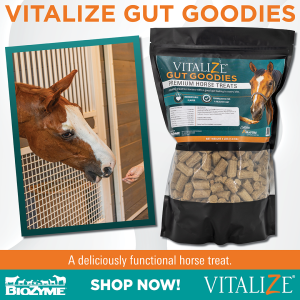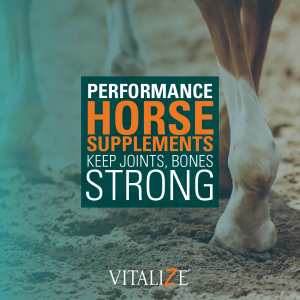
“Nausea, heartburn, diarrhea. . .” The classic jingle for an antacid reminds us that stomach discomfort is never enjoyable. Imagine what it is like for a horse that cannot tell us when their stomach is upset.
When your horse’s stomach is free of disease and discomfort, it has achieved gastric health, and that is the ultimate goal! Unfortunately, in most horses the incidence of gastric ulcers is high, ranging between 50 to 90%. And the symptoms of gastric ulcers in horses can be debilitating.
Why are gastric ulcers in horses so prevalent? The horse’s stomach continuously secretes hydrochloric acid throughout the day and night, regardless of if feed has been ingested. High acid in the stomach, especially in an empty stomach, predisposes the horse to gastric ulcers.
But, for those looking to better understand the issue, what exactly are gastric ulcers? And what signs and symptoms of gastric ulcers in horses should you be on the lookout for? We’re here to break it down for you.
What Are Gastric Ulcers?
Equine gastric ulcer syndrome (EGUS) occurs in all types of horses. The incidence is especially high in competition and performance horses. Gastric ulcers are due to the erosion of the stomach lining caused by prolonged exposure to the normal acid in the stomach.
Unlike ulcers in humans, bacteria do not appear to cause equine gastric ulcers. Horses are designed to graze, with regular forage and roughage intake. Therefore, the stomach continually secretes acid, so gastric ulcers can result when the horse is not eating regularly due to less feed to neutralize the acid.
There are two common types of gastric ulcers in horses: squamous and glandular. The first third of the stomach is the squamous region, whereas the last two-thirds are the glandular region. Both of these regions can develop ulcerations.
Squamous Ulcers in Horses
Squamous ulcers in horses generally occur as a direct result of ongoing exposure to stomach acid. These ulcers tend to form quickly, and they are often associated with high starch diets, lack of ample forage, intense exercise and stress.
The squamous region is more susceptible to ulcers than the glandular region since it does not produce mucous or bicarbonate. Gastric acid can also splash into this region and cause ulcers, particularly when the stomach is empty or when the horse is exercising.
Glandular Ulcers in Horses
Glandular ulcers in horses typically occur when the protective mucus layer that the glands produce is compromised. These ulcers develop slowly, and the exact causes are less well understood. They are less common than squamous ulcers and more difficult to resolve.
Now that we have a general understanding of gastric ulcers in horses and how the different types vary, let’s explore their symptoms.
Symptoms of Gastric Ulcers in Horses
Gastric ulcers can only be truly diagnosed through a gastroscopy, which involves using an endoscope to visualize the stomach lining. However, there are some outward symptoms of gastric ulcers in horses that you should be aware of. Start look for these symptoms if you think your horse is at risk.
Poor Body Condition
Has your horse’s body condition decreased recently? This can be a symptom of gastric ulcers in horses. If your horse’s digestive tract is not feeling up to par, your horse likely won’t be eating. Worse, if it is eating, it might not be converting those consumed nutrients into flesh. A decrease in fleshiness or body condition is often one of the first symptoms of gastric ulcers in horses.
Poor Appetite & Weight Loss
One of the most prevalent signs of ulcers is an unwillingness to finish meals or becoming a finicky eater. This is probably due to the continuous abdominal discomfort your horse is experiencing. Your horse might stop eating grain but be on and off diet. Some horses will balk at eating hay as well.
If your horse’s appetite is dwindling, and it is losing body condition, weight loss is likely to occur. However, weight loss isn’t only due to not eating. It can occur from a decreased absorption of nutrients which is linked with more severe cases of EGUS. Nutrient malabsorption happens when the lining of the stomach or small intestine has been damaged.
Digestive Upset
If you don’t have an appetite, and you’re not eating, your stomach likely isn’t feeling its best. The same can be said for your horse. It’s the domino effect of poor appetite, weight loss and the excess secretion of acid in the stomach all leading to digestive upset.
Remember, the domino effect of digestive upset will continue to affect not only your horse’s lack of appetite and weight loss but also its appearance. Its coat will begin to dull and could lose its luster.
Bad Behavior
You might notice your horse become irritable or show changes in its attitude. Sometimes, your horse fusses when its girth is tightened. This is often a sign of ulcers in horses and may be a result of the pain caused by the ulcers. Horses could become reluctant to work or perform due to the pain caused by the ulcer. Other related symptoms of gastric ulcers in horses are restlessness or discomfort after eating.
Irritability or Discomfort Near the Flanks
Just as the horse can seem girthy, this irritability can extend into the flank area. Unusual irritability and discomfort in or around the flank can be a sign of ulcers. You may notice this when brushing the horse’s sides.
Reduced Performance
And then, of course, there’s the single most critical of potential symptoms of gastric ulcers in horses: a reduction in their performance and recovery.
Intense exercise can cause an increase in abdominal pressure that causes the stomach to compress. This pushes acid from the bottom glandular region to nonglandular or squamous region, putting it in direct contact with intestinal cells that lack natural defenses to neutralize the acid.
Ulcers in the nonglandular region of the stomach are similar to lesions that cause heartburn or gastric reflux disease (GERD). Both heartburn and GERD are common in human athletes who complain of upper GI pain during exercise.
Due to increased pain and abdominal pressure, your horse might seem more lethargic or less energetic than usual. You might notice reduced stamina in your equine partner during exercise as a symptom of gastric ulcers.
Dull Coat Condition
A horse’s hair coat and healthy shine are directly related to its diet and absorption of the necessary nutrients. If it is not eating properly or absorbing the nutrients it needs for a healthy, shiny coat, you might notice a duller hair coat or more shedding than normal.
Acute Colic
In one study, 83% of horses with recurring colic were found to have gastric ulcers. Researchers directly linked ulcers to colic in 28% of those horses. Some colic symptoms could really mean that your horse is actually suffering from gastric ulcers. Watch for your horse pawing at the ground, lying down more than usual, or stretching as if to urinate—all signs of gastric ulcers in horses. Excessive stretching is a sign of abdominal pain.
Changes in Drinking Habits
Your horse might show increased or decreased water consumption compared to what it normally drinks. Water is the most important nutrient for any animal, and your horse should consume at least 10 gallons of water per day. If you notice more or less than this for any amount of time, especially if your horse isn’t exercising, you need to consult your veterinarian immediately.
Teeth Grinding (Bruxism)
Grinding teeth, particularly after eating, is often a sign of gastric ulcers. Teeth grinding during various times can indicate various pain points.
Diarrhea
Diarrhea is common when a horse has an ulcer. Yet, it is a symptom of other illnesses or even occurs when the weather changes or when we make changes to the horse’s diet. Just because your horse has diarrhea, don’t jump to conclusions.
If you’re concerned your horse has a gastric ulcer, or your horse is battling chronic diarrhea, you definitely want to seek the attention of a veterinarian.
Any of these signs may indicate ulcers are present, which can be confirmed via endoscopy. If you think your horse has a gastric ulcer, you should seek the attention of your veterinarian immediately to start a treatment program.
Feed a Preventative Supplement to Help Protect the Stomach
Maintaining a good gut health program with products like Vitalize® is also paramount. In fact, all Vitalize products benefit overall gut health. Vitalize® Alimend® is specifically formulated to support gastric health and GI tissue. Feeding Alimend may relieve occasional gastric issues commonly associated with training, traveling, and performance.
Natural Care for Existing Gastric Discomfort
Alimend is a natural product that supports the gastric health of the horse. If your horse is showing signs of gastric discomfort, we suggest starting it on a stress dose of Vitalize Alimend. Your equine friend will need 2 pumps each morning and 2 pumps each evening.
It contains MHB3® Hyaluronan, beta-glucans from a Lion’s Mane mushroom extract to support the gut and immune system, and AO-Biotics® Amaferm®, a prebiotic research-proven to enhance digestibility. MHB3 Hyaluronan is a multi-patented high molecular weight HA that helps hydrate tissue.
In clinical trials, it has been shown to reduce gastric discomfort in over 90% of horses. You read that right—90 percent! MHB3’s unique properties confer a greater response than any other hyaluronan available on the market.
Why Alimend?
Alimend is unique from other gastric health products because it does not change the pH of the stomach, nor does it prevent acid secretion as many other products do. Because of this, digestion is not negatively impacted, which decreases the chance of negative side effects.
Instead of suppressing acid, Alimend’s formula has a mucoadhesive effect that lines the stomach and is designed to maintain the integrity of the GI tissue. This helps maintain “a good gut feeling.”
Additionally, Alimend utilizes a high molecular weight and highly concentrated hyaluronan for maximum results. It includes a research-proven prebiotic for added gut health, absorption , and immune system support. It is palatable, easy to feed, and contains only natural ingredients.
BioZyme Produces Safe, Accurate Products
BioZyme® Inc., the makers of Vitalize prides itself on producing safe, accurate products for the equine and livestock industries. We are a member of the National Animal Supplement Council (NASC), and its Vitalize products carry the NASC Quality Seal specifically designed for the equine and companion animal health markets.
Additionally, Vitalize utilizes an ionophore-free closed production system. BioZyme has taken great care to ensure that our Vitalize products are safely made and have no risk of ionophore contamination. Finally, several Vitalize equine supplements, including Alimend, were recently Clean Sport tested. Clean Sport testing guidelines were compliant with United States Equestrian Federation (USEF), International Federation for Equestrian Sports (FEI), and the International Federation of Horseracing Authorities (IFHA).
Give your Horses a Good Gut Feeling Today
Are you looking for a way to help prevent gastric ulcers and other digestive issues in your horses? Do you want to give your horses the good gut feeling they deserve? Do you want to prevent these symptoms of gastric ulcers in horses?
It’s time to add Vitalize Alimend to your feed room. You can purchase it online on our website or through one of BioZyme’s online retailers.
If you want to shop locally, you can search for your local BioZyme dealer on our website.
We offer a plethora of other products and educational information through a monthly email. Sign up now to receive that information.
You can also view all the other Vitalize equine and canine products on our website.

